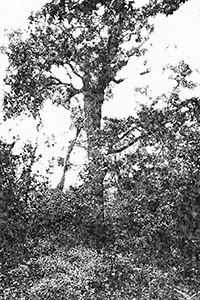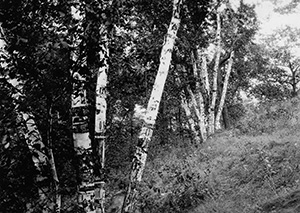
The Writings of Eloise Butler
Notable Features of my Wild Garden, March 1915
[Note: To facilitate identification of plants, we have taken the liberty of adding the information that is within brackets [] and also all the botanical names have been put into italics ]
Among the notable features of the garden, first of all should be noted the lie of the land and the admirable situation, consisting as it does of morainic hills commanding widespread views with intervening valleys, ponds and bogs. My twenty acres of garden within a park of about 600 acres, includes one small tamarack bog, but none of the ponds. One pond, however, full of lilies, lies not a stones throw off, and the other can be seen from my highest hilltop; while a third is distant but a few minutes’ walk. I have a pool in the garden that was formed by building a dam across a brook and it is proposed to make by excavation a sizable pool in one of my meadows for more aquatic plants. As it is, I have varied conditions of soil, moisture and light exposure that satisfy the needs of all the imported plants from other parts of the state.

Above: The marsh and surrounding hillside in early Spring.
The beauty of the landscape is enhanced by the character of the trees and shrubs and their natural grouping. There are many white birches and white oaks, also red maples. These in the fall - the white stems of the birches, the peculiar mulberry red of the white oaks, and the many shades of color afforded by other plants, all set off by the dark green of the tamaracks - makes one understand why the term poignant should be applied to remarkable beauty.

Someone voiced this feeling on seeing the garden in autumnal dress by saying, “It makes me ache to look at this!” One of my white birches on a hillside has eight bolls, while opposite in the meadow a yellow birch rejoices with seven. Between them “Monarch,” the largest white oak in Minneapolis, lifts his aged head and rules the landscape (photos below).
The season is unusually late this year and we have no flowers as yet, save those of the white maple and the yellow accents of hazel, but the swamp is gay with a cordon of redosier dogwood (Cornus sericea), interspersed with yellow stems of willows and saffron-colored Cornus circinata [now Cornus rugosa, Round-leaved Dogwood, no longer extant in the Garden]. Since early March, innumerable pussies on the willows have been purring, “Spring” is here!” although more warmth is needed to bring out the yellow stamens and pistils.



The site of the Wild Garden was chosen particularly on account of the tamarack swamp and adjacent meadows which contained several interesting or beautiful plants that were not to be found elsewhere in the vicinity of Minneapolis, as Linnaea [Twin flower], Showy lady’s-slipper [Cypripedium reginae], False asphodel [Tofieldia] [T. pusilla] and Triglochin [possibly either Marsh or Seaside Arrowgrass]. The pitcher-plant and Turk’s-cap lily also abundant. After linnaea, the chief pride of the garden, are the Fringed gentians, the larger and the smaller, crinita and detonsa, [the smaller is now considered to be Gentianopsis virgata] which grow luxuriantly, tinting the meadows blue in late August late into September.

Other plants that are prized for their beauty and that grow in large effective masses are Buckbean [Menyanthes trifoliata], dwarf cornel [Cornus canadensis], Pyrola asarifolia [Wintergreen], Trientalis americana [Starflower] Coptis trifolia [Threeleaf goldthread], Swamp milkweed [Asclepias incarnata], Eupatorium purpureum [Sweet-scented Joe Pye Weed], E. urticifolium [White Snakeroot].
Heliopsis scabra [Smooth Oxeye, now Heliopsis helianthoides var. scabra], Rudbeckia hirta [Black-eyed Susan], R. laciniata [Green-headed Coneflower], Monarda fistulosa [Wild Bergamot], Galium boreale [Northern Bedstraw], Ceanothus americanus [New Jersey Tea], Lathyrus venosus [Veiny pea], many goldenrods [the masses being chiefly [Solidago] canadensis [Canada Goldenrod], serotina [now Solidago gigantea, Giant Goldenrod] and latifolia [now Solidago flexicaulis - Zigzag Goldenrod]; the most splendid the speciosa [Showy Goldenrod]; the most interesting, S. uliginosa [Bog Goldenrod], a genuine rod in shape]. One of my banks in early spring is thronged with the pretty Anemonella thalictroides [Rue Anemone - Thalictrum thalictroides]. This gives way to an equally profuse growth of Wild geranium or cranesbill [Geranium maculatum], followed for the rest of the season by sunflowers, chiefly [Helianthus] strumosus [Paleleaf Woodland Sunflower] and tuberosus [Jerusalem artichoke]. It is a wonder that the soil can support such a rank succession. I have several other sunflowers in other places, and splendid masses particularly of H. grosseserratus [Sawtooth Sunflower], giganteus [Tall Sunflower], Maximiliani [Maximilian Sunflower] and scaberrimus [Cheerful Sunflower].




Just now large patches of the little Wood anemone, Anemone quinquefolia, vie with the Anemonella. Visitors are interested in comparing these two species with the False rue anemone, Isopyrum biternatum [now Enemion biternatum], usually confused by novices. Marsh marigold [Caltha palustris] is now a golden glory. It is so abundant that cartloads could be removed without apparent loss. This is also true of the Interrupted fern [Osmunda claytoniana]. The marsh fern [Thelypteris palustris var. pubescens] is equally abundant in the meadows. The bog is stocked with splendid growths of Cinnamon fern [Osmunda cinnamomea] and Sensitive fern [Onoclea sensibilis] is much in evidence on the borders. Lady ferns [Athyrium filix-femina] and Maidenhair [Adiantum pedatum] rank next in abundance. We now have forty-one species of ferns, ten of which are indigenous.

The bog is now fragrant with Viola blanda [Sweet white violet], among it is one lovely large mass of V. conspersa [American Dog or Alpine Violet, now Viola labradorica]. A little later, the adjacent meadow will be perfumed with my favorite Smilacina, the trifolia [Threeleaf false lily of the valley]. We have quantities, too, of the other Smilacinas and the closely related Maianthemum.
Introduced orchids thrive well in the garden. Among indigenous species we have Orchis spectabilis [Showy orchid, now Galearis spectabilis], Habenaria hyperborea [Leafy Green Orchis, now Platanthera huronensis], Corallorhiza trifida [Yellow Coralroot], Liparis liliifolia [Large Twayblade], Aplectrum hyemale [Adam & Eve], Pogonia ophioglossoides [Rose Pogonia, now Calopogon pulchellus - Grasspink]. Spiranthes cernua [Nodding Ladies Tresses], besides the already mentioned Showy lady's-slipper.
The most notable spring event is the blossoming of the hawthorns. We have many trees that may be seen near at hand and in the far distance loaded with a snowy fleece of bloom. They blossom like apple trees, more profusely every other year. This is a good year.



More information and photos on some of these plants can be found under these links:
More information and photos can be found under these links: